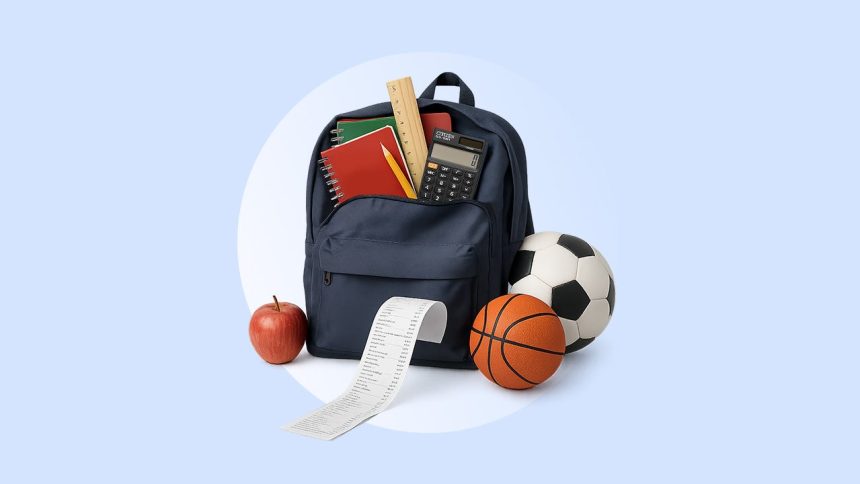I found it funny — and a bit scary — when I noticed Halloween decorations on the shelves beside the back-to-school section of the local grocery store last week. The ghosts and goblins smiled mockingly at me, reminding me of the days when I experienced the horror of another school shopping list.
I learned standard math in high school, and have lived in the world of financial math for most of my adult life. But there’s another type of math you learn when you have kids: parenting math. Like those motion-activated cackling witches in the Halloween section, parenting math laughs maniacally in the face of standard financial advice.
- Chunks of your emergency savings can evaporate if a tooth gets chipped in a soccer match.
- Debt paydown may need to take a backseat to new clothes, so your kid isn’t wearing high waters because he shot up two inches overnight.
Parenting math is like doing complex calculus every single day while watching the circus. Standard money rules weren’t written with moms and dads in mind. But not to worry — with a little planning and a level head, you can keep your sanity and your savings this back-to-school season.
Parenting math starts with the back-to-school backpack
If you’re stressed about how to cover the wide assortment of costs associated with getting your kids’ school year underway, you’re not alone. Nearly 1 in 3 back-to-school shoppers (30 percent) say they’re changing how they shop due to inflation, according to Bankrate’s Back-to-School Shopping Survey. And 20 percent of shoppers say they’ll feel a strain on their budget this back-to-school season.
Yes, prices are still high as inflation refuses to budge. With the advancement of technology and the availability of e-books, I assumed that at least textbooks must be getting cheaper. Data from the Bureau of Labor Statistics squashed my wishful thinking. Compared to last year, some of the biggest budget busters include:
- Educational books and supplies: up 9.4 percent
- Computer software and accessories: up 6.1 percent
- Boys apparel: up 2.1 percent
In addition to standard back-to-school fare like pocket folders and pencils, the school year comes with a litany of other costs that are often overlooked in this conversation. Do any of these costs impact your wallet?
- Gas, oil change and car maintenance: Your role as an unpaid Uber driver comes with costs that grow exponentially with each extracurricular activity your child is involved in. Inevitably, they realize they’ve forgotten something necessary the minute you pull up, sending you back home again to get it.
- Classroom birthdays and holidays: Dietary limitations combined with headcount can leave you scratching your head at the end of the week at how your grocery bill for two bags of treats could be so high.
- Extracurricular culture costs: This goes beyond the one-and-done sporting or dance lessons. I was a “dance dad” for six years, and it’s a cost center culture that includes photos, entry fees, matching outfits, song-themed costumes and recital tickets. The same goes for nearly any extracurricular — soccer snacks, new books for piano lessons, band instruments, and on and on.
- Tutoring or academic coach: If you have the same glazed-over look in your eyes as your child does when you try to help with her homework, a tutor will keep you from admitting how little you learned in high school math, science or English. But it’ll cost ya.
You’ll need a floating fund for fundraisers, (fill-in-the-blank) day appreciation gifts, sports physicals, late registration fees for school trips your kids swear they told you about, mental health care and post-work-meltdown-avoidance impulse purchases. How does anyone keep their head above financial water?
Question of the month: How do you balance back-to-school budgeting with real-life parenting math?
Parenting math and financial perfection are not compatible. Your money plan will change as often as those pencil marks on the door as your kids grow. Flexibility and adaptability are required.
So let’s start with the elephant in the financial room: debt. Sure, avoiding new debt is ideal, but that may not be realistic for many families who live paycheck to paycheck.
If you need to borrow to get your kids set up for success at school, here are some financing options to consider:
- Personal loans: This option comes with fixed interest rates, so if you have good credit, you may snag a personal loan rate below 7 percent and keep borrowing costs down. Select the shortest repayment term you can reasonably afford, and since most lenders don’t charge prepayment penalties, you can repay the loan early if you’re able. The downside: Personal loan funds are disbursed as a lump sum, which isn’t always ideal for ongoing expenses. Aim to borrow only what you’ll use to avoid unnecessary debt.
- Buy now, pay later: This one is probably going to get some frowns from the personal finance powers-that-be — but buy now, pay later is typically an interest-free, fee-free way to finance the $800 or so of expenses without breaking the bank in one weekend. Just be sure you can afford to follow the repayment schedule (a quarter of the balance due every two weeks).
- Credit cards: I’ll bet you thought credit cards would be first on my list, but I avoid them for one reason: Almost 2 in 5 (37 percent) cardholders have maxed out a credit card or come close to it since the Federal Reserve began raising rates in March 2022, according to Bankrate’s Credit Utilization Survey. If a credit card is truly the best (or only) financing option that works for your budget, be sure to repay the balance in full before the end of the statement period to avoid getting stuck on the credit card merry-go-round.
Plan it, don’t panic: Building a budget
But if you’re bound and determined to avoid debt, the solution begins with a solid budget. I typically started my back-to-school plan by reviewing the prior year’s expenses, and then added any costs I knew were upcoming. And because parenting math requires adaptability, I then added 20 percent — like Clark Griswold’s boss did to make up for stiffing him on his year-end bonus in Christmas Vacation.
In addition to reviewing your existing household budget, consider the following strategies to stretch your back-to-school dollar.
- Set up a school sinking fund account. Socking away a little money all year long into a dedicated savings account for school costs can help you avoid pain at the checkout register. Money in your sinking fund can be used for any school-related expense, just be sure to replenish it throughout the year.
- Put out a secondhand needs alert. You’d be surprised how eager your neighbor, cousin or coworker might be to offload clothes and one-time-use graphing calculators if you plant the seed about this year’s expenses.
- Tack on 20 percent for contingency. If your budget is $2,000 for recurring, predictable expenses, adding a $400 line item for last-minute costs should keep you from digging into emergency funds or swiping that credit card.
Money moves kids can learn now
Financial literacy begins at home and is an important parental task. Back-to-school season offers a great opportunity to discuss money with your kids and set them up for financial success as young adults.
- Involve your child in shopping decisions. I know that braving the crowds at Target and fighting over the last pack of graph paper is stressful enough, but this is a time your child should be helping. Start with a shopping budget, and challenge your child to find their own items and stay within budget.
- Pay your kid for their accounting services. Task your child with adding up all the receipts for what you bought. You’ll gauge their math skills, give them a lesson in working to earn and plant a seed about how much their needs and wants cost.
- Set up the “Cheaper Games” competition. Let your kids use their innate (and often superior) online skills to track down the best deal on one of the pricier items on their school lists. The person who finds the lowest price receives a monetary or menu-oriented reward. It will teach basic price-shopping skills and is far safer than playing the Hunger Games.
The final word from Denny, your BFF (best financial friend)
The basic financial advice is still sound: Keep your credit cards empty, your emergency savings full and your retirement fund flowing. As parents, you’ll need to trade perfection for practicality.
For me, parenting math is like those annoying phone updates. The minute you get used to how it works, you’ll get an update and you have to figure it out again.
Why we ask for feedback
Your feedback helps us improve our content and services. It takes less than a minute to
complete.
Your responses are anonymous and will only be used for improving our website.
Help us improve our content
Read the full article here
















